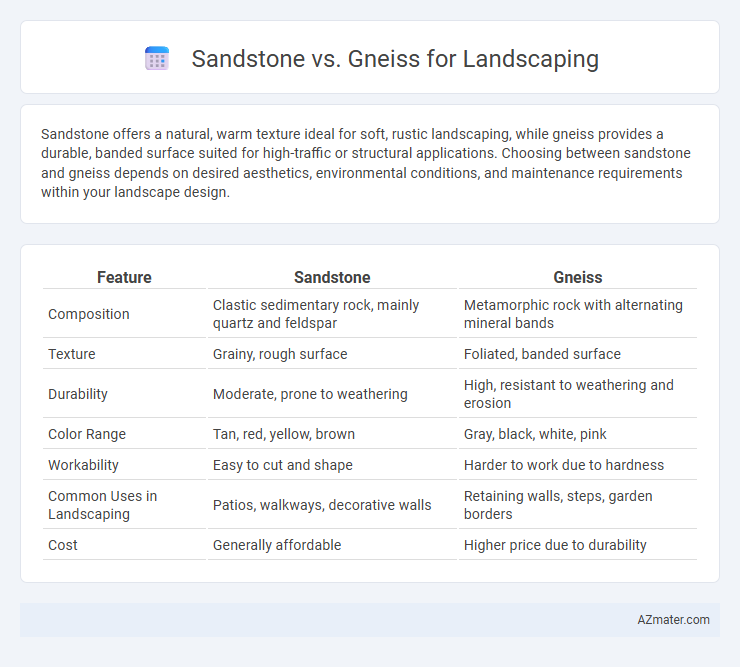Sandstone offers a natural, warm texture ideal for soft, rustic landscaping, while gneiss provides a durable, banded surface suited for high-traffic or structural applications. Choosing between sandstone and gneiss depends on desired aesthetics, environmental conditions, and maintenance requirements within your landscape design.
Table of Comparison
| Feature | Sandstone | Gneiss |
|---|---|---|
| Composition | Clastic sedimentary rock, mainly quartz and feldspar | Metamorphic rock with alternating mineral bands |
| Texture | Grainy, rough surface | Foliated, banded surface |
| Durability | Moderate, prone to weathering | High, resistant to weathering and erosion |
| Color Range | Tan, red, yellow, brown | Gray, black, white, pink |
| Workability | Easy to cut and shape | Harder to work due to hardness |
| Common Uses in Landscaping | Patios, walkways, decorative walls | Retaining walls, steps, garden borders |
| Cost | Generally affordable | Higher price due to durability |
Introduction to Sandstone and Gneiss
Sandstone and gneiss are popular choices for landscaping due to their distinctive textures and durability. Sandstone, a sedimentary rock composed mainly of quartz and feldspar, offers a warm, natural appearance with variable hues ranging from tan to reddish-brown, making it ideal for pathways and garden walls. Gneiss, a metamorphic rock characterized by its foliated texture and alternating mineral bands, provides exceptional strength and a striking visual pattern, often used for retaining walls and decorative accents in outdoor spaces.
Formation and Geological Characteristics
Sandstone forms from compacted sand-sized mineral particles, primarily quartz, deposited in sedimentary environments such as rivers and beaches, resulting in a porous and relatively soft rock ideal for ease of shaping in landscaping projects. Gneiss, a metamorphic rock, originates from high-temperature and high-pressure transformation of igneous or sedimentary rocks, characterized by its foliated texture with alternating mineral bands, providing exceptional durability and resistance to weathering. The distinct formation processes impart sandstone with varied color tones and a softer texture, while gneiss offers structural strength and striking visual patterns, influencing their suitability for different landscaping applications.
Visual Appearance and Texture Comparison
Sandstone offers a warm, earthy palette with a naturally grainy, rough texture that enhances rustic, naturalistic landscaping designs. Gneiss features a sleek, layered appearance with a crystalline texture and a variety of colors, providing a more polished and elegant look. The choice between sandstone's rugged charm and gneiss's striking banded patterns depends on the desired visual impact and tactile feel in outdoor spaces.
Durability and Weather Resistance
Sandstone offers moderate durability with good weather resistance but can erode over time due to its porous nature, making it suitable for decorative landscaping in mild climates. Gneiss, a metamorphic rock, provides superior durability and excellent resistance to weathering, withstanding freeze-thaw cycles and heavy rainfall without significant deterioration. Choosing gneiss enhances long-term structural integrity and reduces maintenance in landscaping projects exposed to harsh environmental conditions.
Cost and Availability
Sandstone is generally more affordable and widely available for landscaping due to its abundant natural deposits and easier quarrying process. Gneiss, with its higher durability and unique banded appearance, tends to be costlier and less commonly found, especially in regions where metamorphic rock formations are limited. Choosing between sandstone and gneiss depends on budget constraints and local availability, with sandstone offering a budget-friendly option and gneiss providing a premium, long-lasting material.
Workability and Installation
Sandstone offers superior workability due to its softer texture, making it easier to cut and shape for custom landscaping designs, while gneiss's hardness requires more specialized tools and effort for installation. The ease of handling sandstone reduces labor costs and installation time, enhancing project efficiency. In contrast, gneiss provides greater durability and weather resistance, but its challenging workability can increase the complexity and expense of landscaping projects.
Environmental Impact
Sandstone has a lower environmental impact due to its abundant availability and less energy-intensive extraction process compared to gneiss, which requires significant quarrying and processing. Sandstone's porosity supports natural water drainage, promoting groundwater recharge and reducing runoff, while gneiss, being denser, can inhibit these natural processes. Choosing sandstone for landscaping enhances sustainability by minimizing carbon emissions and maintaining soil health.
Maintenance Requirements
Sandstone requires minimal maintenance due to its natural durability and resistance to weathering, making it ideal for low-upkeep landscaping projects. Gneiss, while harder and more resistant to scratching and chipping, may need occasional sealing to prevent moisture penetration and maintain its aesthetic appeal over time. Both stones benefit from regular cleaning to remove dirt and debris, but sandstone's softer composition demands more careful handling during installation and upkeep.
Popular Landscaping Uses
Sandstone is widely chosen for landscaping due to its natural earthy tones and durability, making it ideal for patios, walkways, and retaining walls. Gneiss, with its distinctive banded texture and high strength, is often used for decorative garden features, steps, and outdoor cladding. Both stones offer versatile aesthetic appeal, but sandstone's softer texture suits rustic designs, while gneiss provides a more polished, sophisticated look.
Choosing the Right Stone for Your Landscape
Sandstone offers warm earthy tones and a textured surface ideal for pathways and patios that require slip resistance, while gneiss provides a more durable, dense composition with striking foliated patterns suitable for retaining walls and decorative features. Selecting the right stone depends on factors such as climate durability, maintenance needs, and aesthetic preference, where sandstone excels in softer climates but may weather faster, whereas gneiss withstands harsh conditions with minimal erosion. Consider the scale of the project, the desired color palette, and long-term structural stability to ensure the chosen stone complements and endures within your landscape design.

Infographic: Sandstone vs Gneiss for Landscaping
 azmater.com
azmater.com